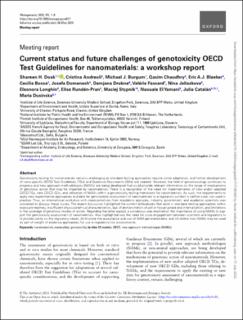Current status and future challenges of genotoxicity OECD Test Guidelines for nanomaterials: a workshop report
| dc.contributor.author | Doak, Shareen H. | |
| dc.contributor.author | Andreoli, Cristina | |
| dc.contributor.author | Burgum, Michael J. | |
| dc.contributor.author | Chaudhry, Qasim | |
| dc.contributor.author | Bleeker, Eric | |
| dc.contributor.author | Bossa, Cecilia | |
| dc.contributor.author | Domenech, Josefa | |
| dc.contributor.author | Drobne, Damjana | |
| dc.contributor.author | Fessard, Valérie | |
| dc.contributor.author | Jeliazkova, Nina | |
| dc.contributor.author | Longhin, Eleonora Marta | |
| dc.contributor.author | Rundén-Pran, Elise | |
| dc.contributor.author | Stepnik, Maciej | |
| dc.contributor.author | El Yamani, Naouale | |
| dc.contributor.author | Catalán, Julia | |
| dc.contributor.author | Dusinska, Maria | |
| dc.date.accessioned | 2023-07-18T06:50:16Z | |
| dc.date.available | 2023-07-18T06:50:16Z | |
| dc.date.created | 2023-07-17T11:30:06Z | |
| dc.date.issued | 2023 | |
| dc.identifier.citation | Mutagenesis. 2023. | en_US |
| dc.identifier.issn | 0267-8357 | |
| dc.identifier.uri | https://hdl.handle.net/11250/3079665 | |
| dc.description.abstract | Genotoxicity testing for nanomaterials remains challenging as standard testing approaches require some adaptation, and further development of nano-specific OECD Test Guidelines (TGs) and Guidance Documents (GDs) are needed. However, the field of genotoxicology continues to progress and new approach methodologies (NAMs) are being developed that could provide relevant information on the range of mechanisms of genotoxic action that may be imparted by nanomaterials. There is a recognition of the need for implementation of new and/or adapted OECD TGs, new OECD GDs, and utilization of NAMs within a genotoxicity testing framework for nanomaterials. As such, the requirements to apply new experimental approaches and data for genotoxicity assessment of nanomaterials in a regulatory context is neither clear, nor used in practice. Thus, an international workshop with representatives from regulatory agencies, industry, government, and academic scientists was convened to discuss these issues. The expert discussion highlighted the current deficiencies that exist in standard testing approaches within exposure regimes, insufficient physicochemical characterization, lack of demonstration of cell or tissue uptake and internalization, and limitations in the coverage of genotoxic modes of action. Regarding the latter aspect, a consensus was reached on the importance of using NAMs to support the genotoxicity assessment of nanomaterials. Also highlighted was the need for close engagement between scientists and regulators to (i) provide clarity on the regulatory needs, (ii) improve the acceptance and use of NAM-generated data, and (iii) define how NAMs may be used as part of weight of evidence approaches for use in regulatory risk assessments. | en_US |
| dc.language.iso | eng | en_US |
| dc.rights | Navngivelse 4.0 Internasjonal | * |
| dc.rights.uri | http://creativecommons.org/licenses/by/4.0/deed.no | * |
| dc.title | Current status and future challenges of genotoxicity OECD Test Guidelines for nanomaterials: a workshop report | en_US |
| dc.title.alternative | Current status and future challenges of genotoxicity OECD Test Guidelines for nanomaterials: a workshop report | en_US |
| dc.type | Peer reviewed | en_US |
| dc.type | Journal article | en_US |
| dc.description.version | publishedVersion | en_US |
| dc.rights.holder | © The Author(s) 2023. | en_US |
| dc.source.journal | Mutagenesis | en_US |
| dc.identifier.doi | 10.1093/mutage/gead017 | |
| dc.identifier.cristin | 2162475 | |
| dc.relation.project | EC/H2020/814425 | en_US |
| dc.relation.project | EC/H2020/101008099 | en_US |
| dc.relation.project | EC/H2020/814401 | en_US |
| dc.relation.project | EC/H2020/814530 | en_US |
| dc.relation.project | NILU: 119011 | |
| dc.relation.project | NILU: 121041 | |
| cristin.ispublished | false | |
| cristin.fulltext | original | |
| cristin.qualitycode | 1 |
Tilhørende fil(er)
Denne innførselen finnes i følgende samling(er)
-
Publikasjoner fra Cristin - NILU [1360]
-
Vitenskapelige publikasjoner [1096]
Vitenskapelige artikler, kapitler og monografier.

